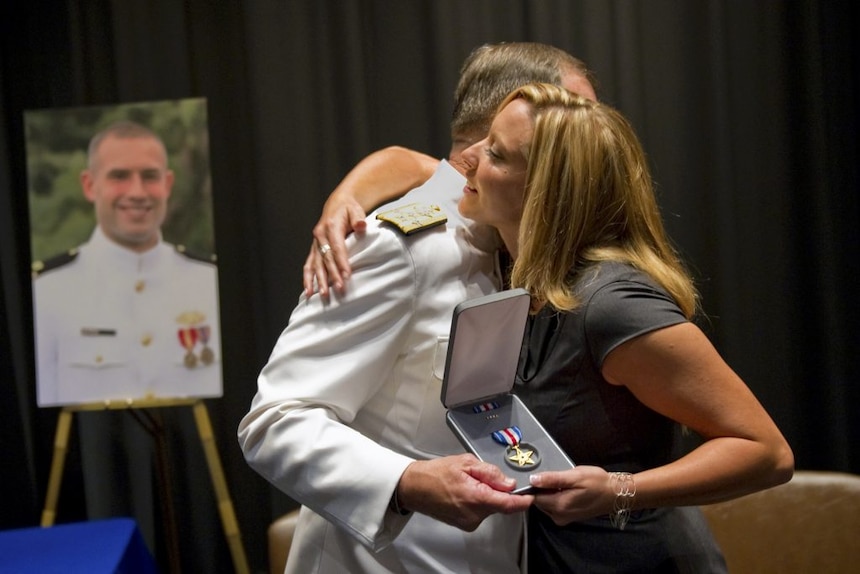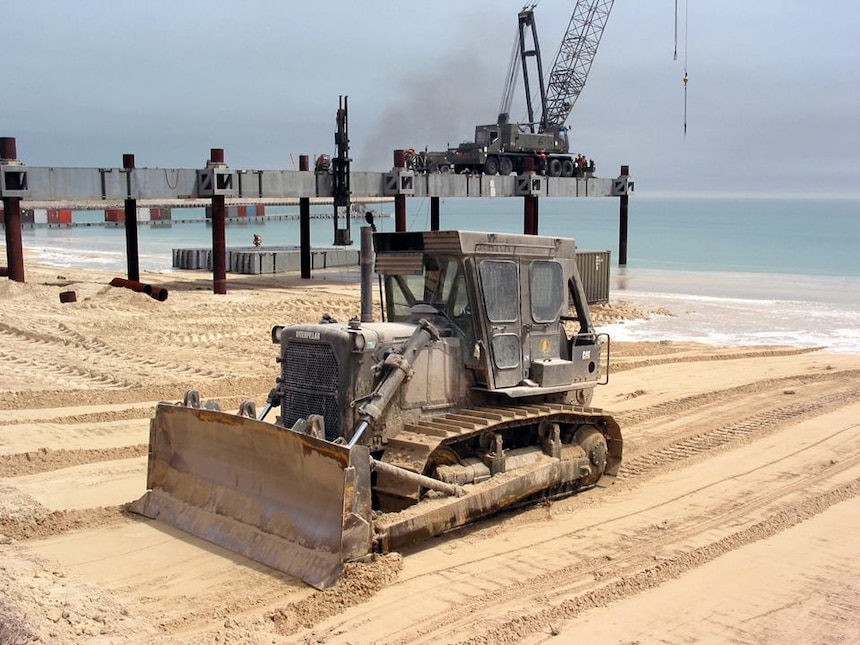March 26
1969: Seabee Teams 0703 and 0704 arrived in Davisville, Rhode Island, from Vietnam for reassignment to Naval Mobile Construction Battalion (NMCB) 7.
1970: Seabee Team 0516 was disestablished.
1970: 21st Naval Construction Regiment (NCR) Detail Yankee (Underwater Construction Team 1) returned to Davisville, Rhode Island from the Navys Atlantic Undersea Test and Evaluation Center (AUTEC).
March 27
1964: On Good Friday, a disastrous earthquake and tidal wave leveled much of the city of Kodiak, Alaska. One day later, Seabee volunteers from Port Hueneme, California, were on the scene working at disaster relief. Over a period of several weeks they restored utilities, provided a dry dock for the heavily damaged fishing fleet and participated in the rehabilitation of the city.
2009: Lt. j.g. Francis L. Toner IV, Civil Engineer Corps (CEC), Naval Facilities Engineering Command (NAVFAC) Hawaii, of Panorama City, California, was killed when an Afghan National Army soldier opened fire on U.S. Navy personnel assigned to Combined Security Transition Command Afghanistan at Camp Shaheen, Mazar-E-Sharif, Afghanistan.

March 28
1969: NMCB 22 was disestablished as an active duty unit.
March 29
Mar. 29-Apr. 1, 1966: NMCB 3 arrived at Chu Lai, Republic of Vietnam (RVN).
March 30
1942: In California, the Oxnard Harbor District formally turned over the Hueneme Harbor to Lt. Gustave G. Werner Jr., CEC. Werner accepted the harbor and adjoining land on behalf of the U.S. Navy. On this site a Seabee support base was built under the name of the U.S. Naval Advance Base Depot. It was the predecessor of the Naval Construction Battalion Center (NCBC), Port Hueneme, California.
1968: NMCB 53 constructed the first Ammi Pontoon Bridge in Vietnam, and became operational on this date.
1970: Seabee Teams 0315 and 0316 returned to the continental United States (CONUS) via government aircraft.
March 31
1943: 65th Naval Construction Battalion (NCB) commissioned at Freetown, Sierra Leone, from a merger of Construction Battalion Detachments (CBD) 1001 and 1002.
1945: ACORNs 7, 12, 25, and 26 decommissioned. (An ACORN was a tailored unit designed to carry out the rapid construction and subsequent operation of a landplane and seaplane advance base. Each ACORN had a construction battalion attached to it, as well as trained personnel to operate the control tower, field lighting, aerological unit, transportation, medical, berthing and messing facilities. A Construction Battalion Maintenance Unit (CBMU) also accompanied each ACORN to maintain the base after the initial construction was completed and the construction battalion had been withdrawn. During the World War II, ACORNs were sent to such places at Guadalcanal, Espiritu Santo, Green Island, Rendova, Treasury Island and Majuro.)
1968: Seabee Team 0912 completed training at the 31st NCR, and deployed to Vietnam via C-118 aircraft.
1968: Detail Echo of NMCB 9 at Hill 494 Quarry Cantonment and Rock Production Facility came under attack at 0225, receiving approximately 25 rounds of mortar fire. Seabee mortar and U.S. Marine Corps (USMC) artillery fire was returned. Seven Seabees were wounded including Construction Mechanic (Construction) James F. Galati, who died as a result of his wounds at 1200 en route to Naval Support Activity Hospital, Da Nang. At 0710, the quarry cantonment sustained a second attack, receiving recoilless rifle fire and approximately 10 rounds of mortar fire, two rounds of which impacted within Detail Echo Mortar Position No. 2. Five Seabees were killed and one seriously injured. Killed in action while directing fire against the enemy were Builder (Light) 3rd Class George R. DeShurley, Builder (Light) Constructionman Mark E. Hodel, Builder (Light) 3rd Class Allan L. Mair, Builder (Light) 3rd Class John F. Peek and Builder (Heavy) Constructionman James R. Retzloff Jr. Subsequent investigations of the area from which enemy fire was initiated revealed that four Viet Cong positions were hit by the Seabee mortar crews return fire, killing at least nine of the enemy.
1968: Capt. John R. Fisher, CEC, relieved Capt. Charles W. Turner, CEC, as Commander, 30th NCR.
April 1
1944: 301st NCB activated at Advance Base Depot Port Hueneme, California. 27th Special NCB commissioned at NCTC Camp Peary, Magruder, Virginia.
1945: One of the largest Seabee stevedore assault operations in the Second World War was handled by 11th Special NCB at the invasion of Okinawa. The assignment began in February 1945 when the battalion was joined by two base companies of untrained personnel. Indoctrination of these recruits in the Seabee stevedore tradition, keep the hook moving, was started immediately. The big battalion was split into two divisions of nine nine-man teams each. The divisions separated, each going to a different staging area where the 18 teams were assigned to 18 different assault ships. Once at the staging area, each team loaded its assigned vessel and then rode that vessel to Okinawa. When the ships arrived off the coast of Okinawa on April 1, 1945, they were spread the entire length of the northern beaches. These were the beaches hit by the Third Amphibious Marines. Once landed, the Seabees unloaded on a 24-hour basis. Unloading was performed under extremely hazardous conditions. Enemy air raids persistently hammered at the shipping. Fourteen casualties were suffered by the 11th Special NCB during the early stages of the campaign. On the day after the invasion, April 2, 1945, six cranes, five bulldozers and a number of floodlight trailers were on the beaches as far north as Nago on the still bitterly contested Motobu peninsula. When the discharge of assault cargo was completed, the Seabee stevedores had a lull of about a week before the second echelon of supply ships arrived. However, during this week the men were not idle. They did excavation and construction work, roughed in roads and helped install anti-aircraft emplacements. Despite the week-long pause in stevedoring and the reduction of working time due to air raids, the end of April saw more than 70,000 tons of ammunition, guns, vehicles and supplies safely ashore and in the hands of the swift-moving assault forces.
Apr.1 May 1, 1946: 33rd Special NCB inactivated at Leyte-Samar, Philippines.
1955: The gymnasium at NCBC, Port Hueneme, California, was dedicated in memory of Rear Adm. Ralph M. Warfield. The ceremonies were attended by high-ranking military leaders and other distinguished guests, including Rear Adm. John R. Perry, chief of the Bureau of Yards and Docks, and Mrs. Warfield, widow of the late admiral. The dedication was held at the gymnasium with eight companies of Seabees and a large group of civilian employees and military dependents in attendance. Prior to his death from a heart attack in 1939, Warfieldhad a most distinguished naval career.
1966: Recommissioning ceremony for 21st NCR held at Davisville, Rhode Island, with Cmdr. David M. Feinman, CEC, in command. NMCBs 1, 6, 7, 49 and 58, while homeported in Davisville, were assigned to the regiment. Main body of NMCB 3 arrived at Chu Lai, RVN.
1967: NMCB 128 commissioned at Construction Battalion Center (CBC), Gulfport, Mississippi.
1968: NMCB 5 s change of command ceremony held with Cmdr. R.B. Wilson, CEC, relieving Cmdr. E.J. Williams Jr., CEC. Seabee Teams 0408 and 0409 arrived in RVN after completing training at CBC, Port Hueneme, California. NMCB 10 advance party, Lt. R.E. Andrews, CEC, officer in charge, one officer and 28 men departed for Port Hueneme.
1969: Main body of NMCB 7 arrived at Davisville, Rhode Island, from Dong Ha, RVN.
Apr. 1-18, 2003: Amphibious Construction Battalions 1 and 2 completed construction of an Elevated Causeway System/Modular (ELCAS/M), a 1,400-foot pier, for the first time in a combat operation, in support of Operation Iraqi Freedom at Camp Patriot, Kuwait.
